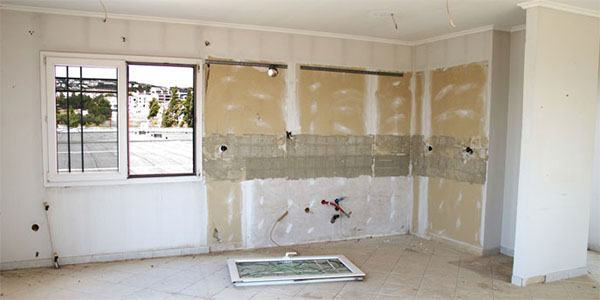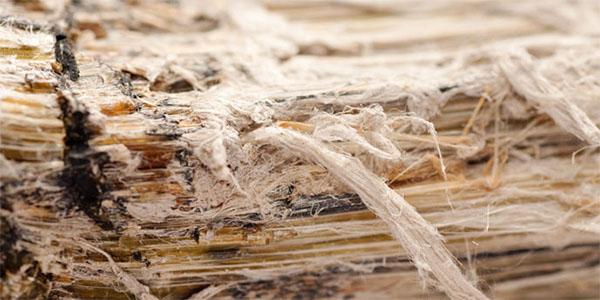How to Identify Asbestos During a Home Renovation

The Complete Guide to Identifying Asbestos
When people hear the word “asbestos,” their first thought is often one of the dozens of personal injury ads they’ve seen on TV featuring a fast-talking voice actor and a bright, bold 1-800 number emblazoned on the screen. Yet despite its association with questionable advertising, asbestos remains a very real danger as nearly 15,000 people die every year from asbestos exposure in the U.S.
The greatest risk for many homeowners occurs when remodeling or renovating an older home that was built before modern-day regulations were put in place. Fortunately, there are precautions you can take to help identify asbestos in your home and prevent it from becoming a major health risk.
Read on to learn more about the signs of asbestos and what you can do to keep your family safe.
What Is Asbestos?
Asbestos is a set of minerals known for their resistance to heat, fire and electricity. Because of these properties, it was widely used in everything from building insulation to oven mitts throughout the 20th century. But by the 1970s, public knowledge of asbestos’ ability to cause cancer, especially a rare, aggressive form of the disease called mesothelioma, caused governments around the world to ban or extremely limit its use in both industrial and consumer products.
Today, asbestos use is heavily regulated in the U.S., yet it still lingers in many homes throughout the country, as Emily Walsh, director of community outreach for the Mesothelioma Cancer Alliance, explains:

“One of the biggest misconceptions, especially with home renovation, is that asbestos is no longer a concern because it’s been regulated. To this day in the United States, certain materials and other products are allowed to contain up to one percent of asbestos, not accounting for those imported from other countries.”
Emily Walsh, Director of Community Outreach, Mesothelioma Cancer Alliance
And even regulations meant to deal with existing asbestos have a huge blind spot. “This regulation [the Asbestos Hazard Emergency Response Act] by the Environmental Protection Agency (EPA) also fails to address the concentrations of asbestos found in homes built before the late 1970s, before regulations were put into place,” says Walsh.

It’s important to note that asbestos is only a health risk in a friable, or dust-like, form, allowing its microscopic fibers to be inhaled. In cases where undisturbed asbestos is found, the best course of action is usually to leave it instead of removing it to avoid contaminating the home with asbestos dust.
What Are the Signs of Asbestos?
But how do you find and identify asbestos in your home in the first place? Part of what makes asbestos so difficult to detect is the fact that it was used in so many different materials, as Walsh explains:
“Asbestos can be found almost anywhere in the home. It was used in a variety of construction products, including cement, insulation, adhesives, siding, roofing tiles, textured paints, and vinyl flooring.”
Despite the difficulty, there are some red flags to look out for when working on your home, especially if it was built prior to the late 1970s, such as:
- Crumbling drywall
- Cracked siding
- Damaged shingles
- Discolored or cracked floor tiles
- Old corrugated cement roofing
- Brittle ceiling tiles or coatings
- Frayed building or piping insulation
Remember, finding any of the above materials doesn’t mean that your home has asbestos. The only way to confirm its presence is by testing the material. “Asbestos can’t really be seen by the naked eye, so it’s important to have your home tested to yield conclusive results,” says Walsh.
Additionally, you can reduce your chances of exposure by following a few basic home improvement safety tips:

“Anyone renovating, either DIYer or professional, should wear the proper gear when taking on a project. This could include wearing an asbestos respirator mask and protective clothing, as loose fibers can cling to clothing and be tracked throughout the house.”
Emily Walsh, Director of Community Outreach, Mesothelioma Cancer Alliance
Looking for other ways to keep your home safe for your family?
Check out our guide to Boosting Home Safety During a Renovation!

What to Do if You Find Asbestos in Your Home
If you suspect you’ve found asbestos in your home, do not touch the material. Look for signs of wear, such as water damage or tears. If the material looks disturbed, limit access to the area and call a licensed asbestos tester to take samples for testing.

“Home inspections are the best place to start. A trained asbestos professional should be the only one testing for the mineral, as the process disrupts the fibers and can lead to exposure. Asbestos only poses a threat once it has been disturbed or damaged, so finding out it is part of your home may serve as a red flag before going through with a renovation.”
Emily Walsh, Director of Community Outreach, Mesothelioma Cancer Alliance
If the material is undamaged, and it doesn’t need to be removed as part of your project, then it is usually better to leave it in place. Consult a specialist to confirm that this is the safest choice for your home.
Who Should You Call for Asbestos Removal?
If the asbestos-containing material is clearly damaged and poses an exposure risk, you will need to call an abatement specialist to have it removed. Professional asbestos removal contractors can be found throughout the country, but you should always verify their credentials with your state’s asbestos program before hiring one.

“If the materials have already been damaged, the only real remedy is to call a professional to remove the toxic mineral. Until then, homeowners may want to restrict entry into that specific room or leave the house until they are sure no one will be exposed.”
Emily Walsh, Director of Community Outreach, Mesothelioma Cancer Alliance
If the asbestos is throughout your home, you may have to stay elsewhere while the abatement specialist removes it. Your contractor will be able to tell you when it is safe to return.
Check Out Dumpsters Near You
How Much Does Asbestos Removal Cost?
Removing asbestos from a home can be expensive, with smaller jobs often falling within the $1,500 to $3,000 range. In cases where asbestos is found throughout the home, removal can easily cost between $20,000 and $30,000.
It is possible that your state may offer financial assistance for costly asbestos removal. Call your regional EPA office or your state’s department of environmental protection for more information on these programs.
The best advice for identifying and removing asbestos in your home is not to panic. As long as you know what to look for and when to call a professional, you’ll be able to keep yourself and your family safe.

“When it comes to renovations, your health and wellbeing should take precedence over everything else, and the best way to do that is by getting your home tested, wearing protective gear, and calling a professional when necessary.”
Emily Walsh, Director of Community Outreach, Mesothelioma Cancer Alliance
If you or a loved one is currently suffering from an asbestos-related illness, visit Mesothelioma.com for resources to help patients and families.



